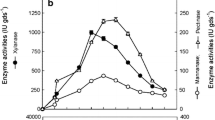Abstract
Rice bran (RB) and de-oiled rice bran (DRB) have been treated and used as the carbon source in acetone–butanol–ethanol (ABE) production using Clostridium saccharoperbutylacetonicum N1-4. The results showed that pretreated DRB produced more ABE than pretreated RB. Dilute sulfuric acid was the most suitable treatment method among the various pretreatment methods that were applied. The highest ABE obtained was 12.13 g/L, including 7.72 g/L of biobutanol, from sulfuric acid. The enzymatic hydrolysate of DRB (ESADRB), when treated with XAD-4 resin, resulted in an ABE productivity and yield of 0.1 g/L h and 0.44 g/g, respectively. The results also showed that the choice of pretreatment method for RB and DRB is an important factor in butanol production.




Similar content being viewed by others
References
Dürre P (2007) Biobutanol: an attractive biofuel. Biotechnol J 2(12):1525–1534. doi:10.1002/biot.200700168
Lee SY, Park JH, Jang SH, Nielsen LK, Kim J, Jung KS (2008) Fermentative butanol production by clostridia. Biotechnol Bioeng 101(2):209–228. doi:10.1002/bit.22003
Lee JY, Jang Y-S, Lee J, Papoutsakis ET, Lee SY (2009) Metabolic engineering of Clostridium acetobutylicum M5 for highly selective butanol production. Biotechnol J 4(10):1432–1440. doi:10.1002/biot.200900142
Jang Y-S, Lee J, Malaviya A, Seung DY, Cho JH, Lee SY (2011) Butanol production from renewable biomass: rediscovery of metabolic pathways and metabolic engineering. Biotechnol J. doi:10.1002/biot.201100059
Ezeji T, Milne C, Price ND, Blaschek HP (2010) Achievements and perspectives to overcome the poor solvent resistance in acetone and butanol-producing microorganisms. Appl Microbiol Biotechnol 85(6):1697–1712. doi:10.1007/s00253-009-2390-0
Al-Shorgani N, Kalil M, Yusoff W (2011) Fermentation of sago starch to biobutanol in a batch culture using Clostridium saccharoperbutylacetonicum N1-4 (ATCC 13564). Ann Microbiol 1–12. doi:10.1007/s13213-011-0347-x
Madihah MS, Ariff AB, Sahaid KM, Suraini AA, Karim MIA (2001) Direct fermentation of gelatinized sago starch to acetone–butanol–ethanol by Clostridium acetobutylicum. World J Microbiol Biotechnol 17(6):567–576. doi:10.1023/a:1012351112351
Qureshi N, Blaschek H (2001) ABE production from corn: a recent economic evaluation. J Ind Microbiol Biotechnol 27:292–297
Qureshi N, Lolas A, Blaschek HP (2001) Soy molasses as fermentation substrate for production of butanol using Clostridium beijerinckii BA101. J Ind Microbiol Biotechnol 26(5):290–295. doi:10.1038/sj.jim.7000131
Ennis BM, Maddox IS (1985) Use of Clostridium acetobutylicum P262 for production of solvents from whey permeate. Biotechnol Lett 7(8):601–606. doi:10.1007/bf01026457
Lee J, Seo E, Kweon D-H, Park K, Jin Y-S (2009) Fermentation of rice bran and defatted rice bran for butanol production using Clostridium beijerinckii NCIMB 8052. J Microbiol Biotechnol 19(5):482–490. doi:10.4014/jmb.0804.275
Tanaka T, Hoshina M, Tanabe S, Sakai K, Ohtsubo S, Taniguchi M (2006) Production of d-lactic acid from defatted rice bran by simultaneous saccharification and fermentation. Bioresour Technol 97(2):211–217
Chandel AK, Narasu ML, Rudravaram R, Pogaku R, Rao LV (2009) Bioconversion of de-oiled rice bran (DORB) hemicellulosic hydrolysate into ethanol by Pichia stipitis NCM3499 under optimized conditions. Int J Food Eng 5(1)
Palmqvist E, Hahn-Hagerdal B (2000) Fermentation of lignocellulosic hydrolysates. II: inhibitors and mechanisms of inhibition. Bioresour Technol 74:25–33
Qureshi N, Ezeji T, Ebener J, Dien B, Cotta M, Blaschek H (2008) Butanol production by Clostridium beijerinckii. Part I: use of acid and enzyme hydrolyzed corn fiber. Bioresour Technol 99(13):5915–5922
Chandel AK, Kumar KR, Singh AK, Kuhad RC (2007) Detoxification of sugarcane bagasse hydrolysate improves ethanol production by Candida shehatae NCIM 3501. Bioresour Technol 98:1947–1950
Kosaka T, Nakayama S, Nakaya K, Yoshino S, Furukawa K (2007) Characterization of the sol operon in butanol-hyperproducing Clostridium saccharoperbutylacetonicum strain N1-4 and its degeneration mechanism. Biosc Biotechnol Biochem 71(1):58–68
Tashiro Y, Takeda K, Kobayashi G, Sonomoto K (2005) High production of acetone–butanol–ethanol with high cell density culture by cell-recycling and bleeding. J Biotechnol 120(2):197–206
Al-Shorgani N, Ali E, Kalil M, Yusoff W (2011) Bioconversion of butyric acid to butanol by Clostridium saccharoperbutylacetonicum N1-4 (ATCC 13564) in a limited nutrient medium. BioEnergy Res 1–7. doi:10.1007/s12155-011-9126-6
Aryee ANA, Simpson BK (2009) Comparative studies on the yield and quality of solvent-extracted oil from salmon skin. J Food Eng 92(3):353–358
Weil JR, Dien B, Bothast R, Hendrickson R, Mosier NS, Ladisch MR (2002) Removal of fermentation inhibitors formed during pretreatment of biomass by polymeric adsorbents. Ind Eng Chem Res 41(24):6132–6138. doi:10.1021/ie0201056
Fond O, Matta-Ammouri G, Petitdemange H, Engasser JM (1985) The role of acids on the production of acetone and butanol by Clostridium acetobutylicum. Appl Microbiol Biotechnol 22(3):195–200. doi:10.1007/bf00253609
Qureshi N, Saha BC, Hector RE, Cotta MA (2008) Removal of fermentation inhibitors from alkaline peroxide pretreated and enzymatically hydrolyzed wheat straw: production of butanol from hydrolysate using Clostridium beijerinckii in batch reactors. Biomass Bioenergy 32(12):1353–1358
Ezeji TC, Qureshi N, Blaschek HP (2007) Bioproduction of butanol from biomass: from genes to bioreactors. Curr Opin Biotechnol 18(3):220–227
Purwadi R, Niklasson C, Taherzadeh MJ (2004) Kinetic study of detoxification of dilute-acid hydrolyzates by Ca(OH)2. J Biotechnol 114(1–2):187–198
Larsson S, Palmqvist E, Hahn-Hägerdal B, Tengborg C, Stenberg K, Zacchi G, Nilvebrant N-O (1999) The generation of fermentation inhibitors during dilute acid hydrolysis of softwood. Enzyme Microb Technol 24(3–4):151–159
Liu Z, Ying Y, Li F, Ma C, Xu P (2010) Butanol production by Clostridium beijerinckii ATCC 55025 from wheat bran. J Ind Microbiol Biotechnol 37(5):495–501. doi:10.1007/s10295-010-0695-8
Marchal R, Rebeller M, Vandecasteele JP (1984) Direct bioconversion of alkali-pretreated straw using simultaneous enzymatic hydrolysis and acetone–butanol fermentation. Biotechnol Lett 6(8):523–528. doi:10.1007/bf00139996
Soni B, Das K, Ghose T (1982) Bioconversion of agro-wastes into acetone butanol. Biotechnol Lett 4:19–22
Hipolito CN, Crabbe E, Badillo CM, Zarrabal OC, Morales Mora MA, Flores GP, MdA HC, Ishizaki A (2008) Bioconversion of industrial wastewater from palm oil processing to butanol by Clostridium saccharoperbutylacetonicum N1-4 (ATCC 13564). J Clean Prod 16(5):632–638
Acknowledgments
We would like to thank Prof. Dr Yoshino Sadazo, Kyushu University, Japan, who provided us with C. saccharoperbutylacetonicum N1-4. This research was supported by the UKM-GUP-KPB -08-32-128 grant.
Author information
Authors and Affiliations
Corresponding author
Rights and permissions
About this article
Cite this article
Al-Shorgani, N.K.N., Kalil, M.S. & Yusoff, W.M.W. Biobutanol production from rice bran and de-oiled rice bran by Clostridium saccharoperbutylacetonicum N1-4. Bioprocess Biosyst Eng 35, 817–826 (2012). https://doi.org/10.1007/s00449-011-0664-2
Received:
Accepted:
Published:
Issue Date:
DOI: https://doi.org/10.1007/s00449-011-0664-2




